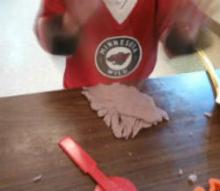You are here
Adventures in Play Dough

Get ready to have fun. The teacher is getting out the play dough.
A recent visit to Room 3 offered me an opportunity to observe your little preschoolers enjoying some play dough. A group of about six children were actively engaged in smooshing, cutting, rulling and pretending with play dough. On this particular day, the teacher had made available some seasonal cookie cutters such as bats, pumpkins, and cats as well as plastic pizza cutters and rolling pins for the childdren to use.
The creations being made were as varied as the children themselves. One girl was flattening and cutting play dough with a pizza cutter. Another boy was busy experimenting on how thick or not thick the play dough needed to be to successfully cut it with a cookie cutter. One was rolling a snake. They were sharing tools and talking about what they were making.
I imagine that you can see some learning involved in the above activities. Play dough really is a wonder toy. Play dough play can easily be enhanced with a variety of add-ons and ad-ins. In addition to the creativity and imagination that is inspired by play dough, it has an added benefit of strengthening the small muscles in the hands, preparing your child for pencil and scissors control later on. Speaking of scissors, play dough is a great material for your child to use to practice cutting.
Let's talk about some of the add-ons and add-ins I mentioned earlier. You can start with sticks, pinecones, leaves and other items from nature; spaghetti sticks, sea shells, colored stones, rice, buttons, etc. In addition to the creativity that can be inspired by add-ons like these, your child's small muscles will learn the new skill of gently inserting the stick spaghetti into the play dough. As for play dough tools, I suggest you get out a plastic pizza cutter, your garlic press, maybe a potato masher, and a plastic knife and fork. Just check out your kitchen and see what you can find. Again, your child's imagination will be ignited and his muscles will have to work hard to squeeze the play dough through the garlic press. Your child will be amazed to see how he can use these tools to manipulate the shape of the play dough. Gather some small boxes or containers and watch your child's play evolve into cooking play, sorting, organizing, matching, etc. You can enhance the sensory experience of play dough by adding sand or cous cous to the dough to give it a different feel. Try adding extracts or koolaid to the play dough to scent it. Adding glitter works well to give it a new look. Try combining colors and scents to make seasonal play dough. And please dont forget the calming effect of play dough. The effects of squeezing and manipulating the play dough can be extremely therapeutic.
Next time you need something to do with your child, make a batch of play dough and enjoy!
Here is my favorite play dough recipe. It's quick and pretty much no fail. I've made it and used it for years in both the classroom and at home.
2 1/2 cups flour
1/2 cup salt
1 Tablespoon Alum
3 Tablespoons cooking oil
2 cups boiling water
Food coloring
Mix flour, salt and alum. Add oil and boiling water. Mix well. Knead in food coloring and enough flour so it is no sticky. Keep refrigerated. Notes: I add my food coloring to the water (makes giving it a uniform color easier). I also add my oil to the boiling water. It will last easily for a couple of weeks in the refrigerator.
I'd love to hear about your child's adventures in play dough. Please share your ideas with me in the comments section.



